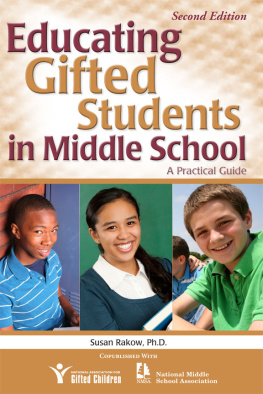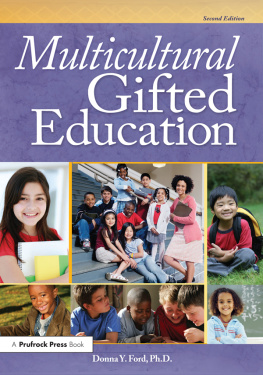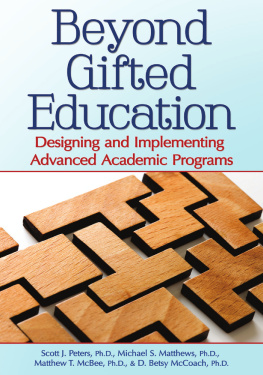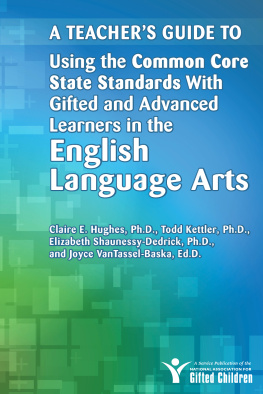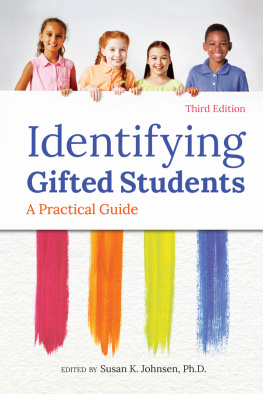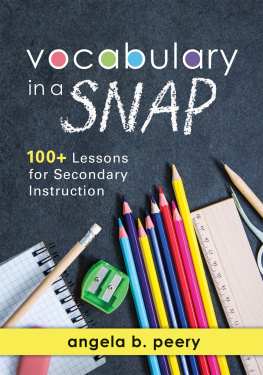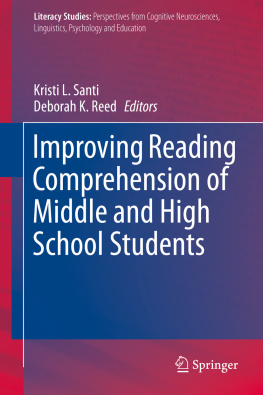Second Edition
Educating
Gifted
Students
in Middle School
A Practical Guide
Second Edition
Educating
Gifted
Students
in Middle School
A Practical Guide
Susan Rakow, Ph.D.

P R U F R O C K P R E S S I N C .
W A C O , T E X A S
Copyright 2011, Prufrock Press Inc.
Edited by Jennifer Robins
Cover design and layout design by Raquel Trevino
ISBN-13: 978-1-59363-877-1
No part of this book may be reproduced, translated, stored in a retrieval system, or transmitted, in any form or by any means, electronic, mechanical, photocopying, microfilming, recording, or otherwise, without written permission from the publisher.
At the time of this books publication, all facts and figures cited are the most current available. All telephone numbers, addresses, and websites URLs are accurate and active. All publications, organizations, websites, and other resources exist as described in the book, and all have been verified. The author and Prufrock Press Inc. make no warranty or guarantee concerning the information and materials given out by organizations or content found at websites, and we are not responsible for any changes that occur after this books publication. If you find an error, please contact Prufrock Press Inc.

Prufrock Press Inc.
P.O. Box 8813
Waco, TX 76714-8813
Phone: (800) 998-2208
Fax: (800) 240-0333
http://www.prufrock.com
Table of Contents
Acknowledgements
Nothing happens in a vacuum. Countless connections with other scholars, friends, students, and family change the way we think and act. For all of those who have helped me grow and think, I am profoundly grateful.
Special gratitude
To Gordon Vars, an extraordinary mentor and friend whose life is a model of scholarly accomplishment and dedication to humanitarian values.
To Jennifer Robins and Joel McIntosh at Prufrock Press, who accepted and supported the need for this book and whose patience is limitless.
To my colleagues and students at Cleveland State University, who continue to inspire my dedication to teaching.
To my parents, Betty and George Bosnick, who gave me the confidence to accept lifes challenges.
To my children, Josh and Becca, whose gifts have illuminated my life and fueled my passion to make change for others.
To my grandchildrenBenjamin, Owen, and Annabecause they are the future for whom this book is written.
And, most of all, to my husband, Larry, because without him in my life, Id probably still be a wannabe cheerleader.
Preface to the
Second Edition
Im an optimist at heart. An idealist, some might say. Most teachers are because we believe that all children can grow, learn, and change and that schools and teachers are essential and critical to this process. However, since 2005, when the first edition of this book was published, there has been little progress in middle schools when it comes to meeting the needs of gifted, talented, high-achieving, and high-potential students. With no national strategy or funding mechanism to support these students, we look at individual states and find there has been a decline in opportunities: At the state level, 26 percent of states provide no funding support to gifted education (National Association for Gifted Children [NAGC], 2009, p. 2). At this writing, even Javits grants (the only federal funds targeted for research in gifted education) are not in the current federal education budget. Beyond budgets, teacher preparation in meeting the needs of gifted students is still lacking. In 36 states, general education teachers... are not required to have any training on the nature and needs of gifted and talented students at any point in their careers (NAGC, 2009, p. 3). Yet increasingly, gifted students are placed in general education classrooms where teachers are unprepared for them.
New views of intelligence and talent development, and an emphasis on preparing all students for college regardless of their skills, temperament, motivation, or interests, often end up working against gifted and advanced learners who are lost in the erroneous belief that all children are gifted, or a misapplication of Carol Dwecks (2006) view that intelligence can always be changed. Although intelligence is obviously not fixed, by middle school we are dealing with a range of starting points for developing individuals intelligence and helping them develop their potential. The same is true with Daniel Pinks (2005) A Whole New Mind and its emphasis on right-brained thinking. Although he touted the value of metaphors and analogies (pp. 134, 139), he neglected the knowledge and analytic thinking abilitiesnot to mention vocabulariesthat provide the foundation for these skills. In addition, he neglected to address the individuals who develop these abilities independently and at earlier ages than their grade-level peers.
Since the first edition of this book, there have been a variety of relevant publications: a new edition of the National Middle School Associations (NMSA, 2010) philosophical framework, This We Believe; the Center for Evaluation and Educational Policys (Plucker, Burroughs, & Song, 2010) Mind the (Other) Gap!, which addresses the excellence gap in K12 education; the Fordham Institutes (Loveless, Farkas, & Duffett, 2008) High-Achieving Students in the Era of NCLB; and The National Research Center on the Gifted and Talenteds (Brighton, Hertberg, Moon, Tomlinson, & Callahan, 2005) The Feasibility of High-End Learning in a Diverse Middle School, as well as Tomlinson and Doubets (2006) Smart in the Middle Grades. All of these publications have added to the research base and discussion about how to serve gifted students in middle school. Advancements in curriculum models for gifted learners, as well as greater attention to and understanding of underserved gifted populations, have also occurred since the first edition. It is my hope that this new edition contributes to greater understanding of how middle schools and middle school teachers can meet the needs of gifted and advanced learners and that it leads to greater collaboration among professionals who straddle both fields of gifted and middle grades education.
Preface to the
First Edition
Ever since I completed my dissertation in 1993 on middle school gifted programs, I expected that someone else would write this book: a practical guide to serving gifted students during their middle school years. But no one has, and there continues to be a rift between the fields of middle school education and gifted education that has been exacerbated by the passage of the No Child Left Behind Act (NCLB, 2001), the publication of Turning Points 2000 (Jackson & Davis, 2000), and other movements toward accountability and minimum competency assessments (e.g., state proficiency tests). Little has been done on a broad scale to bridge the gap with thorough, realistic, and well-supported approaches to understanding and meeting gifted students needs. Teachers, principals, and gifted coordinators need background information, instructional strategies, programs models, and curriculum ideas that enable and motivate them to provide a more effective match between gifted students and their middle school experiences and environments.
As professionals, educators dont shy away from tackling students deficits when they are the result of societal failures; our approach is that every student is important, regardless of the reasons he or she is struggling. And we redouble our efforts. The reasons why gifted students exist are almost equally irrelevant to addressing their problems: inequities in home life and experiences, undeserved advantages bestowed by race or class, genes, exceptional drive, and motivation. We dont know what part of intelligence is due to nature or nurture. By middle school, the primary challenge is to understand the needs of all of our studentsand this includes the giftedand address them, no matter how we may feel about how they got to be exceptional.
Next page
